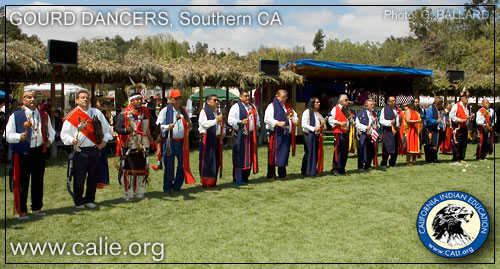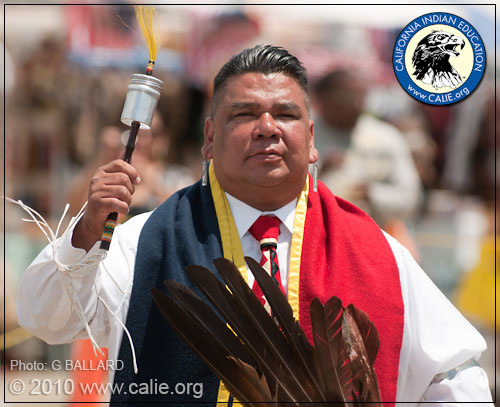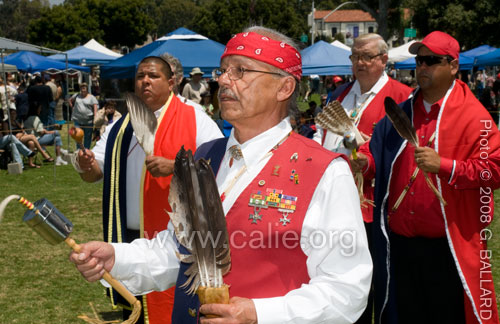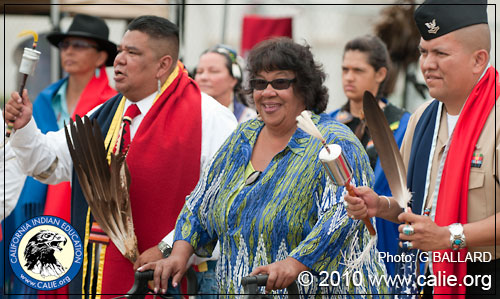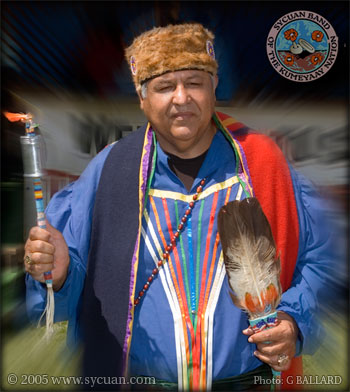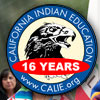 |
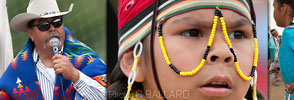 |
 |
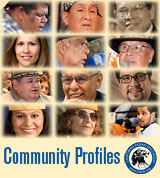


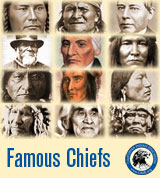
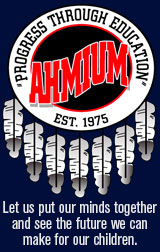


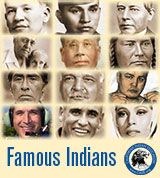


Publishing Corner: Indian Community: Science & Wonder Indian Heros: California Indian Art: CALIE Library: Academic Financial Aid: Tribal Governments: Indian Gaming: |
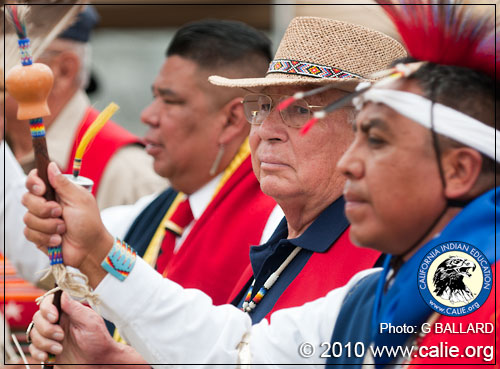 Randy Edmonds (Kiowa gourd dancer), SCAIR Senior Advisor, pictured 2010 playing an American Indian rattle with his fellow Southern California gourd dancers. Kiowa Gourd Dance and Song
According to the Kiowa, in the pow wow world, the Kiowa singers are best recognized for the popularity of the gourd dance. These songs originated with the Kiowa tribe in the Black Hills of South Dakota in the 1700s. This is also a time when they were in close proximity to the Cheyenne and their society songs. For a period of time these gourd dance songs were not presented in public but by the middle of the last century, 1950, there was a revival of this now popular tradition.
Inspiration for the songs, according to the Kiowa story, a Kiowa warrior, the lone survivor of a battle, is trying to find his way back to the tribe. On his way, he hears music and finds a Red Wolf, singing and dancing and holding a fan in one paw and a rattle in the other. Red Wolf feeds the warrior and tells him to take the songs back to the tribe. If you listen closely you will hear the call of the wolf at the end of the songs. Today, most dancers are members of a gourd society. Many are Warriors and Military Veterans of many conflicts. They wear a bandoleer of metal beads and mescal seeds. Over their shoulders and tied to the other side in a cross body bandolier manner, they drape a wool blanket, red on one end, blue on the other. Some are plain and others are decorated with war ribbons and unit patches. In one hand, they hold a fan of feathers, and in the other a rattle, sometimes a gourd or metal can or saltshaker.
The Second World War was a turning point for many Native Americans. The indigenous peoples who were drafted into the military served with great distinction. The military experience was a great eye opener and society leveler. Thereby, to a degree, allowing native soldiers to be the equal of whites. Even to the point that they were allowed to drink alcohol at local bars – This may provoke many other value judgments but remember there were and are still laws against this in Indian Country until 1957 and some states Tribes are still dry. The military experience allowed the plains tribes found a means to translate the old ways into appropriate modern traditions. The warrior societies that had been set-aside during the allotment and assimilation period were reorganized. Fortunately there were people left who still remembered the old ways and the old songs. Women again sang songs of victory (War mothers' Songs) and men sang songs of brave deeds. The warrior societies found a logical and useful extension in serving veterans returning from the Second World War. Much like the non-Indian veterans organizations (e.g. Veterans of Foreign Wars and American Legion) these societies honored the returning soldiers.
Native Americans began writing new songs -- songs of the deeds of the valiant soldiers, songs of mothers for there absent sons, songs of honor much like the old days. A new type of song emerged, the flag song that took the same place as the National Anthem. Among the reorganized societies was the Tia Piah Society. Members of Tia Piah Society (Kiowa warrior society) were still alive who remembered the old days and the old songs. They passed those on and re-established the society as a veterans' organization. As time has gone on it has developed into an important part of the Pow Wow circuit and has engendered an intertribal social dance -- the gourd dance. Primarily a dance for veterans and their families, this dance is found throughout the various nations in the United States. When a young man had distinguished himself enough to be considered a man he might be taken in by one of the six warrior societies. Three of these societies still exist today: The Tia Piah Society (within this also existed the Koitsenko or the ten bravest warriors). Members of this society were the protectors of the tribe. Referred to by other tribes as dog soldiers, these men were willing to lose their lives in defense of the people. They dance with a gourd and a fan. Their emblems are the bandoleer made of silver and mescal beads and a blanket made of red and blue trade cloth. The Kiowa have passed this society on to other organization and tribes as an intertribal veterans dance. Kiowa elders in 1975 officially recognized Golden State Gourd Society, at an Orange county location. Tribal elders, headmen, and friends have provided much information about those traditional customs. These views draw upon both written and oral tradition as well as research done for a number of years. A brief history of the Kiowa Tia Piah Society is provided. According to the Kiowa, this type of dance comes to us from Red Wolf (Ku-ee-Goodle-tey) who gave it is a gift to a brave young warrior. He asked the young warrior to pass it on to other brave men and to protect the people. The society was called Tdien-pei-gah (presently Tia Piah) which means skunk berries. There are several conflicting stories about the origin of this term, but no one is certain how it came to be applied to the gourd dancers.
The Kiowa Tia Piah Society holds its Annual during the Fourth of July South of Carnegie, Oklahoma. Members of the Kiowa Tia Piah Society and other groups that owe their existence to the Kiowa Tia Piah gather together to celebrate the dances of the society. The communication that occurs between the younger and older members of these two societies takes two basic forms. First, there is the formal interaction. This included the gathering of the boys with Grandfather Rabbit and their service at the Annual. Second, there is the informal interaction between younger people and older people throughout the gathering. The Annual truly begins with a religious service preceding the actual dances. Native American Church members arrive early and make preparations for honoring Doyem Daw-k'hee. This service is led by elders and asks blessings of Jesus and His Father upon the gathering and all the participants. It is usually includes a smoke. This sets the tone of the entire gathering. Younger men attend the services and the young boys spend time with Grandfather Rabbit. In an informal way families gather to renew friendships and discuss how the previous year has gone. During the informal gatherings, the elders are respectfully given places of honor, the younger folk listen attentively and join in discussion while the younger ones play together impromptu games. During the following day, Gourd Dancing is done under the direction of the headmen of the Kiowa Tia Piah Society. It is easy to identify these four headmen as they each wear a distinctive turban made from otter fur and bring with them their lance. These four lances are then driven into the ground in a row inside the circle (dance arena) next to the drum that occupies the center of the arena. Each headman usually place his feather bonnet upon his lance after it has been driven into the ground. These lances serve as the symbol of their authority. A headman may choose to honor someone during a given dance session by inviting them to dance with their lance. If so, the lance is removed from the ground and grasped in the honoree's right hand throughout the song. The society members will dance after the starting song. The headman directs the dancers -- none may rise until he rises, none may enter the arena until he enters the arena. The head dancer is always a man of some standing within the community. He is honored as are all those worthy of esteem. The members dance in a large circle around the central drum. This drum is the focus of the universe -- the still point around which the world turns. The women dance behind the men in a larger circle. During the Gourd Dance sessions, the boys of the Rabbit Society serve as helpers. The Rabbit Society gathers together every day under the tutelage of Grandfather Rabbit to learn more about the history of the society and how to be a human being. Grandfather Rabbit teaches these boys the history of the Kiowa through stories. The boys gather around him and willingly listen to his stories. The Society takes a leisurely dinner break where friends and relatives take time to just talk. The children play, the young men meet the young women, the elders talk and tell stories and generally everyone has a good time. Families put together dinner and invite their friends to come and partake in it -- no one goes hungry and no one goes without someone to talk with. It is during this unstructured time that the young and old play together -- always with respect and always having fun. It seems that the elders have almost as much fun watching the young ones play as the young ones have while playing. It is interesting to note that although each generation has been raised with different values in the majority culture, the common experiences of the annual gathering bond them together much more than is often the case in the majority culture. The young people often play hand held video games, something not thought of in the days of the elders. The elders do not seem to look down on this, but often have bought the games for the children. The generations bridge the age divisions created in the majority culture through this interaction during the annual gathering.
This writer, as a member of the Golden State Gourd Society (an urban based group of Intertribal gourd dancers which can trace its foundation to the Kiowa nation), has been privileged to observe firsthand many of the current customs. Gourd rattles in their various forms are some of the oldest musical instruments found on the Plains. Currently gourds are made from traditional bottle gourds, small tin cans, aluminum saltshakers, and metal tea balls. Most construction techniques used in making gourd rattles for the Kiowa Tia Piah Society (a hereditary warrior society) are examined. As a member of the Golden State Gourd Society (an urban based group of Intertribal gourd dancers which can trace its foundation to the Kiowa nation), this writer has been privileged to observe firsthand many of the current customs. Gourd rattles in their various forms are some of the oldest musical instruments found on the Plains. Currently gourds are made from traditional bottle gourds, small tin cans, aluminum saltshakers, and metal tea balls. Hard-shell bottle gourds (Largenaria siceraria) have been used throughout the world for centuries. They make excellent water carriers and can easily be shaped into numerous useful implements. Perhaps the oldest musical instrument found on the plains was a gourd with the seeds dried inside of it. The construction technology is basic and the available materials are shaped with the available technology. The modern gourd rattle is composed of two major parts: a wooden rod and some sort of hollow container. The hollow container (the gourd or metal container) is pierced so that the rod can extend entirely through it. The rod is slightly conical at the top end so that the gourd can not be pushed past a selected point. Once filled with beans, seeds, shot or beads, the gourd is tied into position to the rod. Various decorations are added including peyote beading of the handle and the tightly fitted leather top section. Also, traditionally there is a twine twisted leather braid on the handle and feathers or horsehair at the top. Many fine Native American Oklahoma and western USA artists are producing gourds for use in the gourd dance societies. The popularity of ornamental gourds for decoration and of hand crafted gourds for dancing has made it difficult for the artists to keep up with the demand for their work. The quality of the beadwork and of artistic designs applied to a gourd add much to its value, but essentially and musically the instruments are so designed as to please the ears of the individual dancer.
Southern Plains gourd dance items; Eagle feather fan, gourd stitched handle, hackle trim. Mescal bead bandoleer. Velvet sash with gourd stitch and channette fringe end decoration. Aluminum shaker rattle, wood handle, glass seed bead gourd stitch. Red/blue wool broadcloth blanket, ribbon edging.
Southern plains male regalia Gourd /web stitch beaded end decoration; velvet sash and channette fringe. Joe Chastnah, Commanche, Oklahoma. Historically, hard-shell bottle gourds (Largenaria siceraria) have been used throughout the world for centuries. They make excellent water carriers and can easily be shaped into numerous useful implements. Perhaps the oldest musical instrument found on the plains was a gourd with the seeds dried inside of it. The construction technology is basic and the available materials are shaped with the available technology. The modern gourd rattle is composed of two major parts: a wooden rod and some sort of hollow container. The hollow container (the gourd or metal container) is pierced so that the rod can extend entirely through it. The rod is slightly conical at the top end so that the gourd can not be pushed past a selected point. Once filled with beans, seeds, shot or beads, the gourd is tied into position to the rod. Various decorations are added including peyote beading of the handle and the tightly fitted leather top section. Also, traditionally there is a twine twisted leather braid on the handle and feathers or horsehair at the top. Many fine Native American Oklahoma and western USA artists are producing gourds for use in the gourd dance societies. The popularity of ornamental gourds for decoration and of hand crafted gourds for dancing has made it difficult for the artists to keep up with the demand for their work. The quality of the beadwork and of artistic designs applied to a gourd add much to its value, but essentially and musically the instruments are so designed as to please the ears of the individual dancer. Kiowa Gourd Dance Songs (Recorded July 1997. Sung by Billy Evans Horse, Dorita Horse, Charlie Horse, Matt Horse, Stephanie Starr, Adam Gainey, and Eric Lassiter) Starting Song (430 KB). This song starts all Gourd Dances. Red Wolf Song (502 KB). Note the ending of this song. All Gourd Dance songs end in this way. As Billy Evans Horse notes, “at the end, you’re supposed to make a noise like a wolf.” Satethieday’s Song (491 KB). Singers sing several versions of this “song with words.” The version sung here is featured in The Power of Kiowa Song, as told by Billy Evans Horse. The words in this song translate thus:
Brush Dance Song (474 KB). When the Kiowas gathered for the K’aw-tow (literally “gathering,” more commonly known as the “Sun Dance”), they came together to build the K’aw-tow lodge, where the dancing would take place. These structures were built of large cottonwood trees and then covered with brush. The Brush Dance commemorated this act of building. Today, Brush Dances are often performed before Gourd Dances at annual celebrations. The very same songs are often sung in the Gourd Dance throughout the rest of the year. Many Brush Dance songs that have words reference the flirting and courting that occurred during the building of the K’aw-tow lodge. This “song with words” translates thus:
Hunting Horse’s Song (554KB). This song belonged to a well-known Kiowa, Hunting Horse. It is a “song with words,” but it is rarely sung as such, as it is here. The words translate thus:
“Charlie Brown” (641KB). This song normally ends a Gourd Dance, but it is by no means a “quitting song.” It is one among many “bhawl dawgeah” or “fast songs,” songs sung for the Gourd Dance’s close. Buffalo Dance Song (238 KB). The Buffalo Dance commemorates the migrating of buffalo into Kiowa land. According to Billy Evans Horse, these songs were sung at the K’aw-tow. Today, singers often sing these songs to close a Gourd Dance, especially at annual Gourd Dance celebrations. Selections of articles featuring the Gourd dance The First Annual Veteran’s Day Gourd Dance of Tulsa was a success. Hosted by Native American Times, Comanche Nation Funeral Home, and American Airlines. Liz Gray 11/17/2006
The First Annual Veteran’s Day Gourd dance was a success last weekend with gourd dancers, war mother societies and family and friends coming together to give honor and celebrating the return of loved ones from war. The elders said it was the first time in history of having a Veteran’s day Gourd Dance for all tribes on this special day. It was an opportunity for the sponsors to give back to the community and celebrate Native American Heritage Month at the same time. “We felt like there was a need for the community to come together for these two occasions, Veteran’s Day and Native American Heritage Month,” said Adam Proctor, Veterans Dance Coordinator and Sales Manager for Native American Times. “We wanted to celebrate our 10th anniversary by giving back to the people who support us.”
CUTLINE: Lowell Nibbs and Cheevers Coffey of Comanche Little Ponies visit between songs. All of the veterans were equally glad about the dance and all look forward to coming back next year. It was a time of good feelings- a dance specifically for the Veterans. “You could tell by the gourd groups that were there and the veterans who traveled from long distances that it was strictly for them,” said Proctor. “We wanted to showcase our veterans and let people know that they fought for our country. We are celebrating those that returned by recognizing and honoring what they did.” There were eight gourd groups that attended and one war mother’s society: Comanche Little Ponies, Four Corners Gourd Society, Lenape Gourd Clan, Cherokee Red Star Gourd Society, Osage gourd Clan, Buffalo Post 38, and the Otoe Missouri War Mothers’ Chapter 14.
CUTLINE: Phillip Coon, Muscogee Creek, POW of WWII survivor of the Bataan Death March spoke at the Gourd Dance of appreciation of the people and the honor that he received. He was a guest of honor at the Gourd Dance and was honored with a blanket and honor dance. Although Coon was 86 it was the first time he had attended a traditional gourd dance such as this. “It meant a lot to him to attend,” said his son Mike Coon. Some of his class mates were there from Haskell such as Cheevers Coffee and Loretta Coffee. “It was real good for him being there,” said Mike. “He sure enjoyed himself.” “Because my grandpa was a veteran of WWII, I felt like it was important for my generation to acknowledge and honor the generations before us and the sacrifices they made,” said Adam Proctor, “We wanted to give back to the community and this was the way we wanted to do it.” The MC of the event, Archee Mason (Osage) said it was a good dance. He said you can tell when it’s a “good dance” was by how the evening progressed. It appeared everyone felt good and the rhythm of the drum and the dancers movement became more powerful as the evening progressed. “After speaking with our elders I realized there were many events that have become commercialized and didn’t have the ability to take time to socialize,” said Sheldon Gore, Business Manager and co-publisher of Native Times. “It reminded them of the old days where they would gather and get to know their families and their clans. Respect was built that way. Today, they said so many of the pow-wows were competitive and without a sense of respect.”
CUTLINE: Wife, Martha Coon looks on with pride as she watches her husband, Phillip speak at the Native American Times Gourd Dance. Sheldon Gore, who is a veteran himself of Desert Storm, said he felt like it was more than remembering the last generation and giving honor to veterans of the last five wars. “Their guards were down and their hearts were open. They respected each other and remembered each other’s family legacies,” he said. “We remember all the wars and their history that are spoken of and memorialized by monuments of different things across the country but the sense I got of this dance was deeper than WWI or II, Vietnam, Korea or Desert Storm. There was a sense of loss going back to the removal of our traditional land . A price paid by each family.” Gore went on to say that it is these types of events that let our youth receive a sense of pride. It lets them know who they are by looking back at where their family and tribe came from and the price that was paid, he said. So they can stand against the challenges life gives them. “I’m very proud of what the people of our newspaper have done and the hard work that went into that,” said Gore. “I’m proud of this organization and we are far from perfect but the one thing we have always kept first in our business is the people. That’s the rule that I live by. I’ve tried to instill in each person that works here this principal and I hope that it shows in our newspaper.” Native American veterans mark their long heritage of service to their country Judy Nichols The Native American veterans, those who still could, rose from their chairs on Thursday as the drums began. Gathered on Veterans Day were men like Phil Carrillo, 59, of the Laguna Tribe in New Mexico, who served in Vietnam, and women like Ida Amiotte, 81, an Oglala Sioux, who was an Army postal worker in World War II.
The men began to dance. They rocked from foot to foot and raised their gourds. The rattle filled the air. They danced to celebrate their service, honor their dead and remember their brothers and sisters now serving in Iraq. The gourd dance originated with the Kiowa tribe in the Black Hills of South Dakota in the 1700s. According to the story, a Kiowa warrior, the lone survivor of a battle, is trying to find his way back to the tribe. On his way, he hears music and finds Red Wolf, singing and dancing and holding a fan in one paw and a rattle in the other. Red Wolf feeds the warrior and tells him to take the songs back to the tribe. Today, dancers must be members of a gourd society. They wear a bandoleer of metal beads and mescal seeds. Over their shoulders, they drape a wool blanket, red on one end, blue on the other. Many are decorated with war ribbons and unit patches. In one hand, they hold a fan of feathers, and in the other a rattle, usually metal, sometimes an old saltshaker. Carrillo said the red represents the blood spilled in battle, the fan a shield, and the rattle a weapon. Delfred Leslie, 54, a Hopi who was in the Air Force in Vietnam, draped a U.S. flag over one arm. It was a gift from his son Gary, 23, who is serving with the Air Force in Korea. "He took it to the Mideast," Leslie said. As the songs played, the dancers formed a circle around the drummers, sometimes dancing in place, sometimes moving in a circle. "Some of the songs are vocables," Carrillo said. "Some have words. They talk about the battles, coming home from the battle." At one point, John White Shirt, 57, a Mandan-Hidatsa-Arapaho, who was in the Navy in the 1960s, brought forward Ida Amiotte for an honor dance. The dancers filed by, one at a time, dropping money at her feet. Each stopped, raised his fist of dollars, dropped it, shook her hand and that of the next man in line. At the end of the dance, Amiotte gathered the money and put it on the drum for the singers. Finally: You're invited! Description: *********************************************************** laokee wrote you this personal note: Just sending an invite to come and visit the site I'm trying to start for the Gourd Society. Not much in there yet, but I'm trying to keep it updated. Oh and don't forget to fill in your info. *********************************************************** Check it out! Join the group and you can: Post a message on the Message Board Add some photos to the Photo Album Join now References: Boyd, Maurice and Pauahty, Linn (1981). Kiowa Voices: Ceremonial Dance, Ritual and Song, Volume I. Fort Worth, Texas: The Texas Christian University Press,. |
CALIF INDIAN EDU NETWORK: AHMIUM.org | SCAIR.org | SDICENTER.org | APAPAS.com
—
WEB SITE DESIGN
www.calie.org COPYRIGHT 2008-Present • ALL RIGHTS RESERVED

